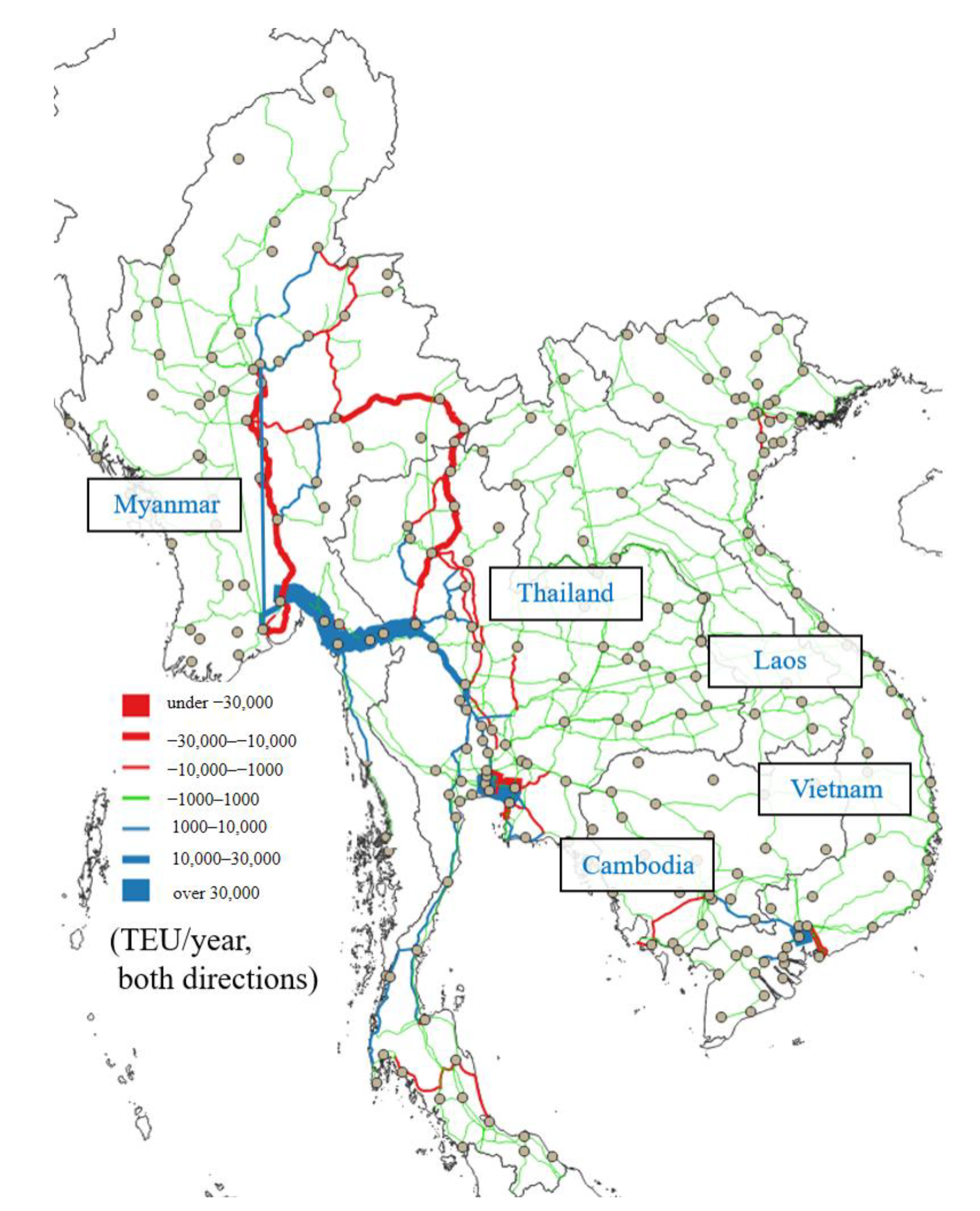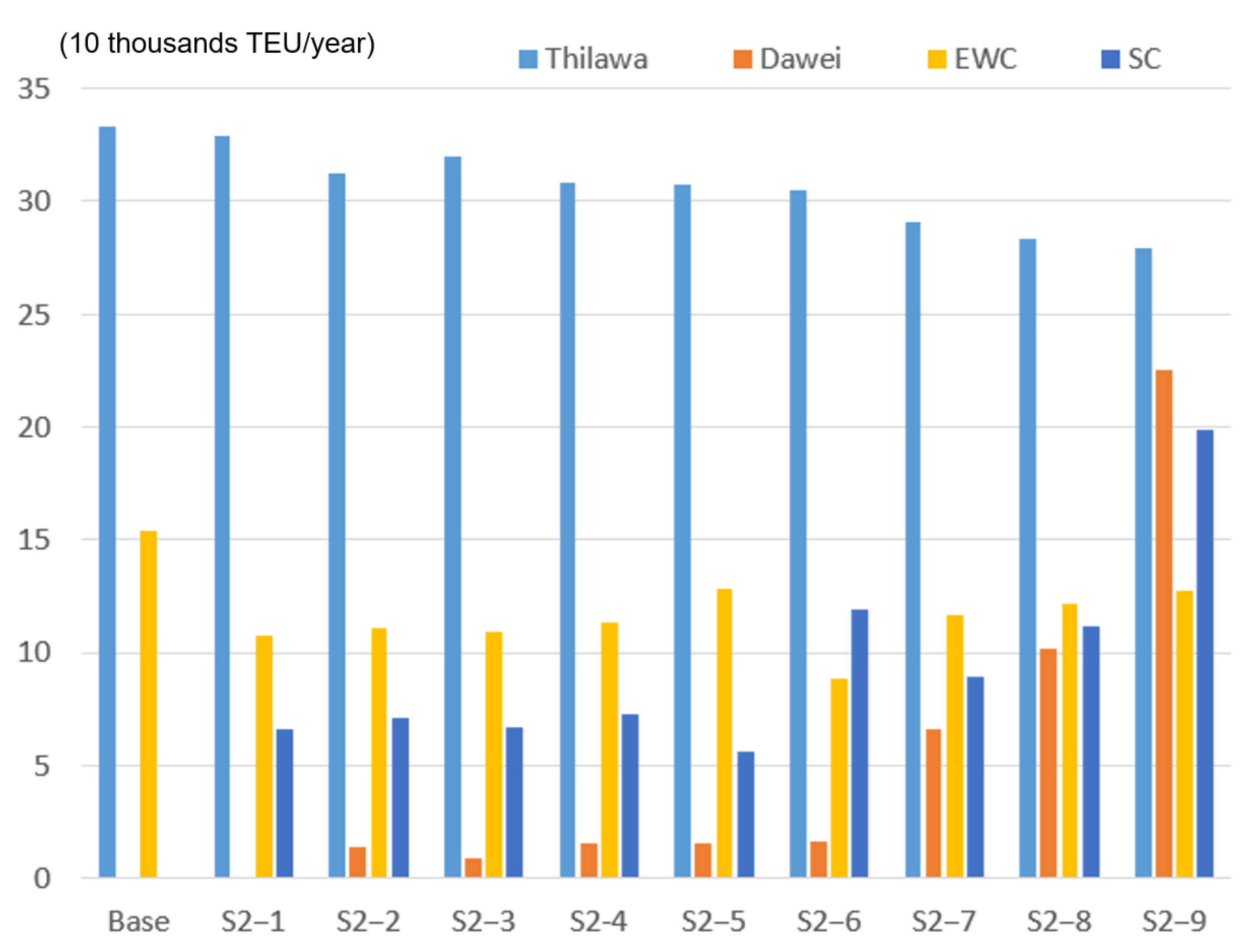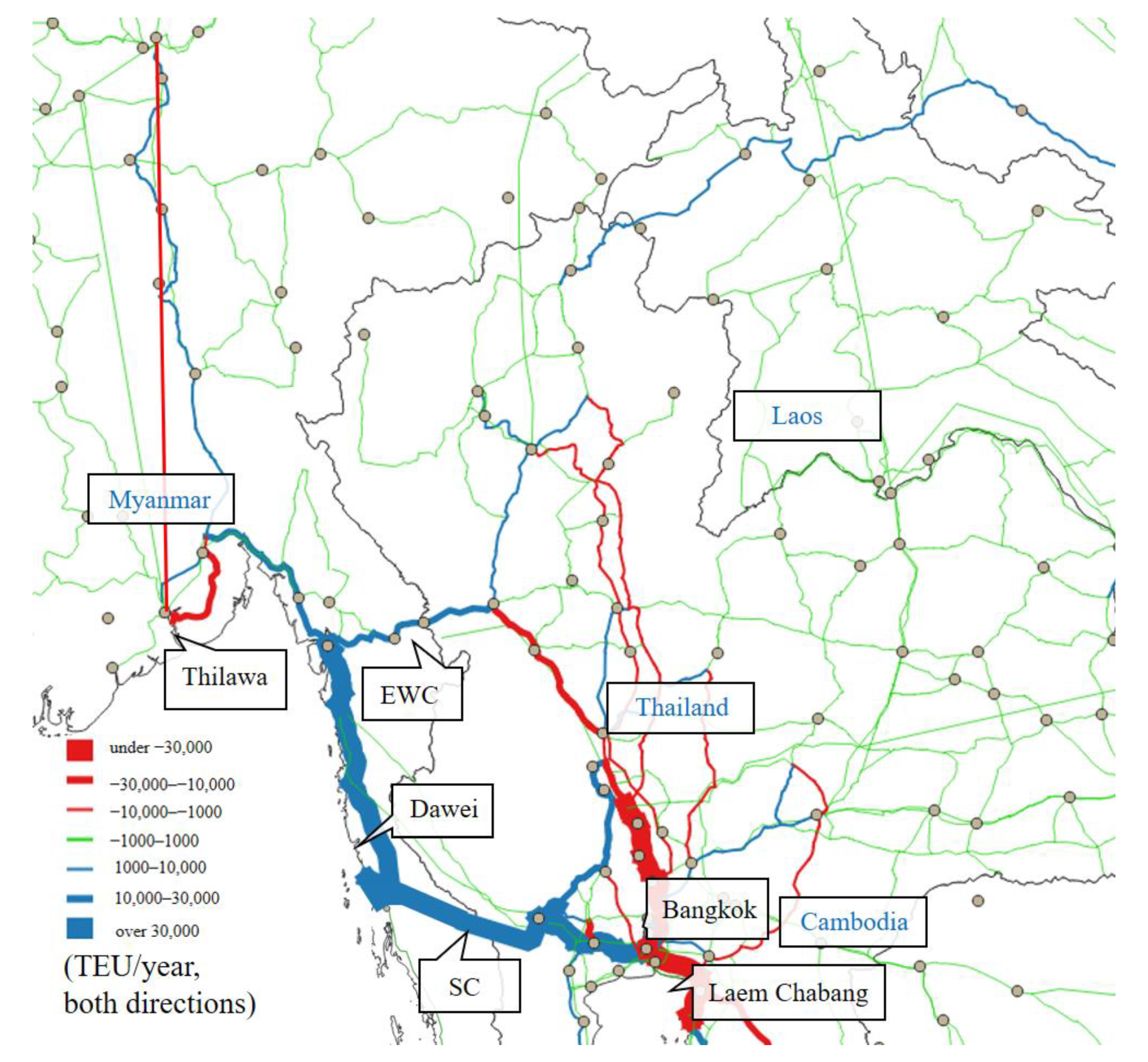Impact on Myanmar’s Logistics Flow of the East–West and Southern Corridor Development of the Greater Mekong Subregion—A Global Logistics Intermodal Network Simulation
Abstract
1. Introduction
2. Literature Review
3. International Logistics Environment in Myanmar
4. Simulation Model
4.1. Overview of the Model
4.2. Input Data
4.3. Model Calculations
5. Model Validation
5.1. Baseline Scenario Setting and Container Throughput
- −
- Railway service: Speed—10 km/h; Frequency—7 trains/week; Handling time—24 h; Distance-proportional cost—1.75 USD/TEU/km,
- −
- Inland waterway transport service: Speed—10 km/h; Frequency—7 services/week; Handling time—48 h; Distance-proportional cost—0.75 USD/TEU/km,
- −
- Level of service in the EWC: Truck speed in Myanmar/Laos/Vietnam section—20 km/h; Thai section—40 to 50 km/h,
- −
- Cross-border coefficient: = 0.4,
- −
- The SC and Dawei port: not available,
- −
- Variance parameters for stochastic assignment: θ = 0.01,
- −
- Shipper’s time value of freight: vt = 0.5 (USD/TEU/hour).
5.2. Model Share and Sensitivity Analysis of International Transport between Myanmar and Thailand
6. Policy Simulations for GMS Economic Corridors
6.1. Infrastructure Development of the EWC
6.1.1. Truck Speed Improvement in the EWC
6.1.2. Border Barrier Change in the EWC
6.2. Construction and Improvement of the SC and Dawei Port
6.2.1. Development of the SC
6.2.2. Opening of Dawei Port and the Calling of Liner Services that Call at Thilawa Port
6.2.3. Calls of Bay of Bengal Service to Dawei Port
6.2.4. Calls of European Service to Dawei Port
6.3. Summary of Policy Simulations
7. Conclusions
Author Contributions
Funding
Data Availability Statement
Conflicts of Interest
References
- Asian Development Bank. Asian Development Outlook. 2019. Available online: https://www.adb.org/publications/asian-development-outlook-2019-update (accessed on 14 April 2020).
- Shibasaki, R. Basic concept. In Global Logistics Network Modelling and Policy: Quantification and Analysis for International Freight; Shibasaki, R., Kato, H., Ducruet, C., Eds.; Elsevier: Amsterdam, The Netherlands, 2020; Chapter 5; pp. 99–104. [Google Scholar] [CrossRef]
- Tavasszy, L.; Minderhoud, M.; Perrin, J.F.; Notteboom, T. A strategic network choice model for global container flows: Specification, estimation and application. J. Transp. Geogr. 2011, 19, 1163–1172. [Google Scholar] [CrossRef]
- International Transport Forum (ITF)-OECD. ITF Transport. Outlook. 2015. Available online: http://www.keepeek.com/Digital-Asset-Management/oecd/transport/itf-transport-outlook-2015_9789282107782-en#page1 (accessed on 19 December 2020).
- Holguín-Veras, J.; Kalahasthi, L.; Campbell, S.; González-Calderón, C.A.; Wang, X. Freight mode choice: Results from a nationwide qualitative and quantitative research effort. Transp. Res. Part. A Policy Pract. 2020, 143, 78–120. [Google Scholar] [CrossRef]
- Aritua, B.; Havenga, J.; Simpson, Z.; Chiew, E.W.L. Unlocking India’s Logistics Potential: The Value of Disaggregated Macroscopic Freight Flow Analysis; World Bank Policy Research Working Paper. 2018. Available online: https://openknowledge.worldbank.org/bitstream/handle/10986/29371/WPS8337.pdf?sequence=1&isAllowed=y (accessed on 19 December 2020).
- Meersman, H.; Sutalo, N.; Voorde, E.V.; Hassel, E.; Vanelslander, T. Belt and Road Initiative: More competition between sea and rail? A generalized cost approach. In Freight Transport. Modeling in Emerging Countries; Kourounioti, I., Tavasszy, L., Friedrich, H., Eds.; Elsevier: Amsterdam, The Netherlands, 2020; Chapter 9; pp. 185–212. [Google Scholar] [CrossRef]
- Hassel, E.; Meersman, H.; Voorde, E.V.; Vanelslander, T. Impact of scale increase of container ships on the generalised chain cost. Marit. Policy Manag. 2016, 43, 192–208. [Google Scholar] [CrossRef]
- Halim, R.A. Strategic Modeling of Global Container Transport Networks. Ph.D. Thesis, Delft University of Technology, Delft, Netherlands, 2017. [Google Scholar] [CrossRef]
- Kawasaki, T.; Kobayashi, M.; Shibasaki, R. Southern Africa: Overcoming corridor and border challenges for landlocked countries. In Global Logistics Network Modelling and Policy: Quantification and Analysis for International Freight; Shibasaki, R., Kato, H., Ducruet, C., Eds.; Elsevier: Amsterdam, The Netherlands, 2020; Chapter 15; pp. 301–320. [Google Scholar] [CrossRef]
- Shibasaki, R.; Kawasaki, T. South Asia: Impact simulations of logistics projects in India, Bangladesh, and Sri Lanka. In Global Logistics Network Modelling and Policy: Quantification and Analysis for International Freight; Shibasaki, R., Kato, H., Ducruet, C., Eds.; Elsevier: Amsterdam, The Netherlands, 2020; Chapter 12; pp. 223–251. [Google Scholar] [CrossRef]
- Shibasaki, R. Global maritime container shipping model. In Global Logistics Network Modelling and Policy: Quantification and Analysis for International Freight; Shibasaki, R., Kato, H., Ducruet, C., Eds.; Elsevier: Amsterdam, The Netherlands, 2020; Chapter 6; pp. 105–119. [Google Scholar] [CrossRef]
- Shibasaki, R. Intermodal transport super-network model. In Global Logistics Network Modelling and Policy: Quantification and Analysis for International Freight; Shibasaki, R., Kato, H., Ducruet, C., Eds.; Elsevier: Amsterdam, The Netherlands, 2020; Chapter 7; pp. 121–134. [Google Scholar] [CrossRef]
- Shibasaki, R.; Watanabe, T.; Araki, D. How is model accuracy improved by usage of statistics? An example of international freight simulation model in East Asia. Asian Transp. Stud. 2010, 1, 33–45. [Google Scholar] [CrossRef]
- Iwata, T.; Kato, H.; Shibasaki, R. Influence of transportation infrastructure development on freight traffic flow patterns in GMS. In Gender, Roads and Mobility in Asia; Kusakabe, K., Ed.; Practical Action Publishing: Rugby, UK, 2012; pp. 25–32. [Google Scholar]
- Kosuge, N.; Shibasaki, R.; Sanui, K.; Okubo, K. Comprehensive simulation of Cambodian international logistics policies using the GTAP and Global Logistics Intermodal Network Simulation Model. In Proceedings of the 8th International Conference of Transportation and Logistics, Surabaya, Indonesia, 6–8 September 2020. [Google Scholar]
- Kawasaki, T.; Hanaoka, S.; Nguyen, L.X. The valuation of shipment time variability in Greater Mekong Subregion. Transp. Policy 2014, 32, 25–33. [Google Scholar] [CrossRef]
- Kawasaki, T.; Hanaoka, S.; Nguyen, L.X. Inland cargo flow modelling considering shipment time variability on cross-border transport. Transp. Plan. Technol. 2015, 38, 664–683. [Google Scholar] [CrossRef]
- Strutt, A.; Stone, S.; Minor, P. Trade facilitation in the Greater Mekong Subregion: Impacts of reducing the time to trade. J. GMS Dev. Stud. 2008, 4, 1–20. [Google Scholar]
- Stone, S.; Strutt, A. Transport infrastructure and trade facilitation in the Greater Mekong Subregion. Trade Facil. Reg. Coop. Asia 2010, 5, 1–31. [Google Scholar] [CrossRef]
- Tansakul, N.; Suanmali, S.; Ammarapala, V. Perception of logistics service provider regarding trade facilitation for cross border transportation: A case study of east-west economic corridor. Int. J. Logist. Syst. Manag. 2018, 29, 131–150. [Google Scholar] [CrossRef]
- Kudo, T.; Kumagai, S. Growth policy and regional balance: Developmental state-building in Myanmar. In Developmental State Building: The Politics of Emerging Economies; Takagi, Y., Kanchoochat, V., Sonobe, T., Eds.; Springer: Singapore, 2019; Chapter 7; pp. 135–156. [Google Scholar] [CrossRef]
- Black, J.; Kyu, T. Critical evaluation of Mandalay dry port, Myanmar. In Proceedings of the 5th International Conference on Logistics and Transportation, Paris, France, 5–8 November 2013. [Google Scholar]
- Zin, A.N. A Comparative Analysis of Dry Port Developments in Developed and Developing Countries: An Implication for Myanmar Dry Ports. Master’s Thesis, World Maritime University, Malmö, Sweden, 2019. [Google Scholar]
- Nam, K.; Win, E. Competitiveness between road and inland water transport: The case of Myanmar. Transp. Probl. 2014, 9, 49–61. [Google Scholar]
- Sukdanont, S.; Pechdin, W.; Tawinnorppanan, P. Possibly utilizing intermodal transport with coastal shipping for Thailand-Myanmar’s cross border transport. Asian Transp. Stud. 2019, 5, 600–616. [Google Scholar] [CrossRef]
- Isono, I.; Kumagai, S. Dawei revisited: Reaffirmation of the importance of the project in the era of reforms in Myanmar. Econ. Res. Inst. ASEAN East. Asia 2013, 99, 1–8. [Google Scholar]
- Isono, I. The High-speed railway (HSR) service, The Eastern Economic Corridor’s development, and Thailand: A geographical simulation analysis. In High-Speed Railway, the EEC, and the Change of the Landscape of Thailand and its Neighboring Countries (Bangkok Research Center Research Report); Hiratsuka, D., Ed.; Institute of Developing economies Japan External Trade Organization: Tokyo, Japan, 2018; Chapter 2; pp. 19–35. [Google Scholar]
- Shepherd, B.; Wilson, J.S. Trade facilitation in ASEAN member countries: Measuring progress and assessing priorities. J. Asian Econ. 2009, 20, 367–383. [Google Scholar] [CrossRef]
- Sy, B.; Lacaza, R.; Villejo, S.J.V. An Analysis of the Impact of ASEAN’s Logistics Performance on Trade Flows Using Linear and Non-linear methods in an Augmented Gravity Model. Logist. Res. 2020, 13, 1–22. [Google Scholar] [CrossRef]
- Opasanon, S.; Kitthamkesorn, S. Border crossing design in light of the ASEAN Economic Community: Simulation based approach. Transport. Policy 2016, 48, 1–12. [Google Scholar] [CrossRef]
- Jiang, Y.; Qiao, G.; Lu, J. Impacts of the new international land-sea trade corridor on the freight transport structure in China. Res. Transp. Bus. Manag. 2020, 35, 100419. [Google Scholar] [CrossRef]
- Suvabbaphakdy, S.; Toyoda, T.; Czerkawski, C. Enhancing trade flows in ASEAN plus six. Appl. Econom. Int. Dev. 2011, 11, 207–224. [Google Scholar]
- Zheng, C.; Liu, Z.; Wang, C.; Wang, X.; Xu, B. A system dynamics model of the interaction of aviation logistics with regional economy development in Guangxi faced to CAFTA. In Proceedings of the International Conference on E-Business and Information System Security, Wuhan, China, 23–24 May 2009. [Google Scholar]
- Japan International Cooperation Agency. Data Collection Survey on National Logistics in Republic of the Union of Myanmar. 2018. Available online: https://openjicareport.jica.go.jp/728/728/728_104_12305694.html (accessed on 3 May 2020).
- Greater Mekong Subregion Secretariat. Asian Development Bank. Available online: https://greatermekong.org/ (accessed on 31 October 2020).
- Shibasaki, R.; Nishimura, K.; Tanabe, S.; Kato, H. Belt and road initiative: How does China’s BRI encourage the use of international rail transport across the Eurasian continent? In Global Logistics Network Modelling and Policy: Quantification and Analysis for International Freight; Shibasaki, R., Kato, H., Ducruet, C., Eds.; Elsevier: Amsterdam, The Netherlands, 2020; Chapter 16; pp. 321–335. [Google Scholar] [CrossRef]
- World Bank Group: Doing Business Website. Trading Across Borders. 2016. Available online: https://www.doingbusiness.org/en/reports/global-reports/doing-business-2016 (accessed on 31 December 2020).
- MDS Transmodal Inc. MDS Containership Databank; MDS Transmodal Inc.: Chester, UK, August 2016. [Google Scholar]
- IHS Markit Ltd. World Trade Service (WTS) Database; IHS Markit Ltd.: London, UK, 2016. [Google Scholar]
- Statistics Ministry of Thailand. Labor Force Survey in Thailand. 2016. Available online: http://web.nso.go.th/ (accessed on 3 May 2020).
- Finance Ministry of Vietnam. Statistics of Exports and Imports by Province/City. 2016. Available online: https://www.customs.gov.vn/ (accessed on 3 May 2020).
- Japan Marine Equipment Association. Survey on the Future Plan and Future Trend of Maritime Industry in Myanmar. 2019. Available online: https://www.jstra.jp/PDF/4f27eb41204c1515fbd847f74049587cbdb9fc9f.pdf (accessed on 11 June 2020).
- Ministry of Land, Infrastructure, Transport and Tourism (MLIT), Japan. Feasibility Study on Promoting Modal Shift of Inland Transportation to Freight Railways in the Republic of the Union of Myanmar. 2015. Available online: https://www.mlit.go.jp/common/001230933.pdf (accessed on 11 June 2020).
- Inter National Civil Aviation Organization. On Flight Origin and Destination; ICAO: Montreal, QC, Canada, 2016. [Google Scholar]
- Comi, A.; Polimeni, A. Assessing the potential of short sea shipping and the benefits in terms of external costs: Application to the Mediterranean Basin. Sustainability 2020, 12, 5383. [Google Scholar] [CrossRef]











| Papers | Developing a Simulation Model Considering Both Maritime and Land Transport Network | Including the Entire Terrestrial ASEAN | Analyzing Myanmar’s Policy |
|---|---|---|---|
| Shibasaki et al. [14] | x | x | |
| Iwata et al. [15] | x | x | |
| Kosuge et al. [16] | x | x | |
| Kawasaki et al. [17] | x | x | |
| Kawasaki et al. [18] | x | ||
| Strutt et al. [19] | |||
| Stone and Strutt [20] | x | x | |
| Tansakul et al. [21] | x | ||
| Kudo and Kumagai [22] | x | ||
| Black and Kyu [23] | x | ||
| Zin [24] | x | ||
| Nam and Win [25] | x | ||
| Sukdanont et al. [26] | x * | x | |
| Isono and Kumagai [27] | x ** | x | x |
| Isono [28] | x | ||
| Shepherd and Wilson [29] | x | ||
| Sy et al. [30] | x | ||
| Opasanon and Kitthamkesorn [31] | x | ||
| Jiang et al. [32] | x | ||
| Suvabbaphakdy et al. [33] | x | ||
| Zheng et al. [34] | x | ||
| This study | x | x | x |
| Country | Zone | Indicator | Source |
|---|---|---|---|
| Myanmar | 70 | GRP | Kudo and Kumagai [22] |
| Thailand | 77 | GRP | Statistics Ministry of Thailand [41] |
| Vietnam | 62 | Trade volume | Finance Ministry of Vietnam [42] |
| Cambodia | 24 | Sales and GDP growth by region | Kosuge et al. [16] |
| Laos | 17 | GRP | Kudo and Kumagai [22] |
| Country | Port | Observed (A) (TEU) | Estimate (B) (TEU) | Difference (A)–(B) (TEU) | Error Rate |
|---|---|---|---|---|---|
| Vietnam | Haiphong | 708,921 | 3,141,070 | 2,432,149 | 304.1% |
| Da Nang | 233,815 | 141,384 | −92,431 | −39.5% | |
| Qui Nhon | 76,840 | 27,764 | −49,076 | −63.9% | |
| Ho Chi Minh | 4,354,555 | 2,407,315 | −1,947,240 | −44.7% | |
| Cai Mep Thi Vai | 947,317 | 815,257 | −132,060 | −13.9% | |
| Vietnam Total | 6,321,448 | 6,532,790 | 211,342 | 3.3% | |
| Cambodia | Sihanoukville | 367,880 | 303,614 | −64,266 | −17.5% |
| Cambodia Total | 367,880 | 303,614 | −64,266 | 17.5% | |
| Thailand | Laem Chabang | 5,105,178 | 5,430,096 | 324,918 | 6.4% |
| Bangkok | 974,112 | 462,490 | −511,622 | −52.5% | |
| Songkhla | 86,135 | 546,910 | 460,775 | 534.9% | |
| Thailand Total | 6,165,424 | 6,439,496 | 274,072 | 4.4% | |
| Myanmar | Thilawa | 319,146 | 333,225 | 14,079 | 4.4% |
| Myanmar Total | 319,146 | 333,225 | 14,079 | 4.4% |
| Scenario | Truck Speed in Myanmar Section of the EWC (km/h) | |
|---|---|---|
| Base | 20 | 0.4 |
| S1-1 | 50 | 0.4 |
| S1-2 | 80 | 0.4 |
| S1-3 | 20 | 0 |
| S1-4 | 20 | 0.2 |
| S1-5 | 20 | 0.6 |
| S1-6 | 20 | 1 |
| Scenario | Availability of the SC and the Pattern of Calls at Dawei Port | SC Speed (km/h) |
|---|---|---|
| Base | Without the SC and Dawei port | − |
| S2-1 | SC only added | 20 |
| S2-2 | In addition to S2-1, all services calling at Thilawa port call at Dawei port for northbound | 20 |
| S2-3 | In addition to S2-1, all services calling at Thilawa port call at Dawei port for southbound | 20 |
| S2-4 | In addition to S2-1, all services calling at Thilawa port call at Dawei port for both northbound and southbound | 20 |
| S2-5 | Same as S2-4 | 10 |
| S2-6 | Same as S2-4 | 40 |
| S2-7 | In addition to S2-4, 14 new South Asia services call at Dawei port | 20 |
| S2-8 | In addition to S2-7, 1 new European services call at Dawei port | 20 |
| S2-9 | In addition to S2-9, 3 new European services call at Dawei port | 20 |
| Scenario | Thilawa | Dawei | EWC | SC | ||||
|---|---|---|---|---|---|---|---|---|
| Export | Import | Export | Import | Thailand to Myanmar | Myanmar to Thailand | Thailand to Myanmar | Myanmar to Thailand | |
| S2-1 | 107,820 | 221,559 | 0 | 0 | 83,747 | 24,008 | 62,832 | 3532 |
| S2-2 | 106,753 | 205,934 | 3490 | 10,085 | 87,314 | 23,823 | 67,338 | 3481 |
| S2-3 | 103,074 | 216,453 | 4318 | 4164 | 85,363 | 25,243 | 64,341 | 3501 |
| S2-4 | 103,584 | 204,381 | 5820 | 9763 | 88,268 | 24,925 | 69,187 | 3463 |
| S2-5 | 103,552 | 204,250 | 5782 | 9785 | 102,785 | 25,872 | 53,740 | 2516 |
| S2-6 | 103,572 | 203,755 | 5784 | 9763 | 71,286 | 24,928 | 87,130 | 3509 |
| S2-7 | 93,582 | 196,868 | 34,248 | 31,724 | 88,918 | 27,391 | 79,720 | 9146 |
| S2-8 | 92,422 | 197,121 | 39,082 | 39,088 | 88,908 | 28,843 | 83,282 | 14,172 |
| S2-9 | 87,884 | 186,456 | 160,734 | 49,732 | 99,420 | 29,034 | 172,304 | 13,377 |
Publisher’s Note: MDPI stays neutral with regard to jurisdictional claims in published maps and institutional affiliations. |
© 2021 by the authors. Licensee MDPI, Basel, Switzerland. This article is an open access article distributed under the terms and conditions of the Creative Commons Attribution (CC BY) license (http://creativecommons.org/licenses/by/4.0/).
Share and Cite
Yamaguchi, T.; Shibasaki, R.; Samizo, H.; Ushirooka, H. Impact on Myanmar’s Logistics Flow of the East–West and Southern Corridor Development of the Greater Mekong Subregion—A Global Logistics Intermodal Network Simulation. Sustainability 2021, 13, 668. https://doi.org/10.3390/su13020668
Yamaguchi T, Shibasaki R, Samizo H, Ushirooka H. Impact on Myanmar’s Logistics Flow of the East–West and Southern Corridor Development of the Greater Mekong Subregion—A Global Logistics Intermodal Network Simulation. Sustainability. 2021; 13(2):668. https://doi.org/10.3390/su13020668
Chicago/Turabian StyleYamaguchi, Takuya, Ryuichi Shibasaki, Hiroyuki Samizo, and Hisanari Ushirooka. 2021. "Impact on Myanmar’s Logistics Flow of the East–West and Southern Corridor Development of the Greater Mekong Subregion—A Global Logistics Intermodal Network Simulation" Sustainability 13, no. 2: 668. https://doi.org/10.3390/su13020668
APA StyleYamaguchi, T., Shibasaki, R., Samizo, H., & Ushirooka, H. (2021). Impact on Myanmar’s Logistics Flow of the East–West and Southern Corridor Development of the Greater Mekong Subregion—A Global Logistics Intermodal Network Simulation. Sustainability, 13(2), 668. https://doi.org/10.3390/su13020668





